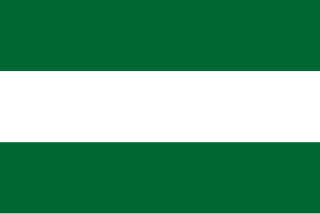
The Durrani Empire, also called the Sadozai Kingdom and the Afghan Empire, was an Afghan empire founded and built by Ahmad Shah Abdali in parts of Central Asia, the Middle East and South Asia. At its maximum extent, the empire ruled over the modern-day countries of Afghanistan and Pakistan, as well as parts of northeastern and southeastern Iran, eastern Turkmenistan, and northwestern India.

The First Anglo-Afghan War was fought between the British Empire and the Emirate of Afghanistan from 1839 to 1842. Initially, the British successfully intervened in a succession dispute between emir Dost Mohammad (Barakzai) and former emir Shah Shujah (Durrani), whom they installed upon capturing Kabul in August 1839. The main British Indian force occupying Kabul along with their camp followers, having endured harsh winters as well, was almost completely annihilated during its 1842 retreat from Kabul. The British then sent an Army of Retribution to Kabul to avenge the destruction of their previous forces, defeating the Afghans and having demolished parts of the capital. After recovering prisoners, they withdrew from Afghanistan by the end of the year. Dost Mohammed returned from exile in India to resume his rule.

The Africa Service Medal is a South African campaign medal for service during the Second World War, awarded to members of the Union Defence Forces, the South African Police and the South African Railways Police. The medal was originally intended for service in Africa, but it was later extended to cover service anywhere in the world.

Major-General Sir Robert Henry Sale was a British Army officer who commanded the garrison of Jalalabad during the First Afghan War and was killed in action during the First Anglo-Sikh War.
British campaign medals are awarded to members of the British Armed Forces, Allied forces and civilians participating in specified military campaigns. Examples include the Defence Medal, for homeland defence in World War II, and the Atlantic Star for World War II sea service in the Atlantic.
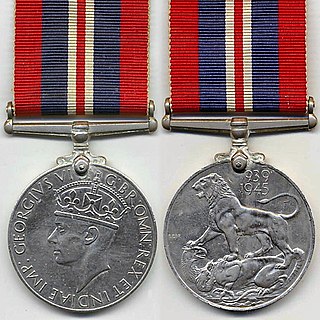
The War Medal 1939–1945 is a campaign medal which was instituted by the United Kingdom on 16 August 1945, for award to citizens of the British Commonwealth who had served full-time in the Armed Forces or the Merchant Navy for at least 28 days between 3 September 1939 and 2 September 1945.

The British War Medal is a campaign medal of the United Kingdom which was awarded to officers and men of British and Imperial forces for service in the First World War. Two versions of the medal were produced. About 6.5 million were struck in silver and 110,000 in bronze, the latter awarded to, among others, the Chinese, Maltese and Indian Labour Corps.

Bala Hissar is an ancient fortress located in the south of the old city of Kabul, Afghanistan. The estimated date of construction is around the 5th century AD. Bala Hissar sits to the south of the modern city centre at the tail end of the Kuh-e-Sherdarwaza Mountain. The Walls of Kabul, which are 20 feet (6.1 m) high and 12 feet (3.7 m) thick, start at the fortress and follow the mountain ridge in a sweeping curve down to the river. It sports a set of gates for access to the fortress. The Kōh-e Shēr Darwāzah mountain is behind the fort.

The Battle of Ghazni took place in the city of Ghazni in central Afghanistan on Tuesday, July 23, 1839 during the First Anglo-Afghan War.
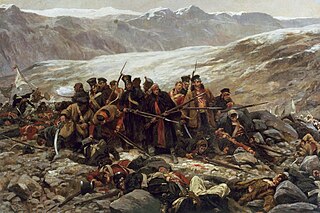
The 1842 retreat from Kabul took place during the First Anglo-Afghan War. At the beginning of the conflict, British and East India Company forces had defeated the forces of Afghan Emir Dost Mohammad Barakzai and in 1839 occupied Kabul, restoring the former ruler, Shah Shujah Durrani, as emir. However a deteriorating situation made their position more and more precarious, until an uprising in Kabul forced the then commander, Major General Sir William Elphinstone, to withdraw the garrison. To this end he negotiated an agreement with Wazir Akbar Khan, one of the sons of Dost Mohammad Barakzai, by which his army was to fall back to the British garrison at Jalalabad, more than 90 miles (140 km) away. As the army and its numerous dependents and camp followers began its march, it came under attack from Afghan tribesmen. Many of the column died of exposure, frostbite or starvation or were killed during the fighting.

Mir Mehrab Khan Baloch was the Khan (ruler) of the princely state of Kalat in what is now the Balochistan province of Pakistan during the nineteenth century.

The Afghanistan Medal, sanctioned on 19 March 1881, was awarded to members of the British and Indian armies who served in Afghanistan between 1878–1880 during the Second Afghan War, the first war being from 1839–1842.

The New Zealand War Medal was a campaign medal authorised in 1869 to be awarded to Imperial and Colonial troops involved in the New Zealand Wars of 1845–47 and 1860–66. The New Zealand Wars were previously known as the Māori Wars, Anglo-Māori Wars or Land Wars.

The China War Medal was issued by the British Government in 1843 to members of the British and Indian forces who took part in the First Anglo-Chinese War (1839–42). The medal was designed by William Wyon.

The South Africa Medal (1880), often referred to as the Zulu War Medal, is a campaign medal instituted in 1880 and awarded by the British Government to members of the British Army, Royal Naval Brigade and Colonial Volunteers who were involved in a series of South African tribal wars in the Cape of Good Hope, Colony of Natal and Transvaal between 1877 and 1879, most notably for the Anglo-Zulu War of 1879.
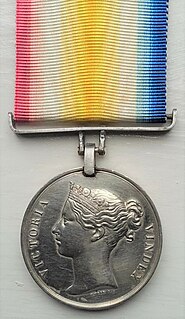
The Candahar, Ghuznee, Cabul Medal was awarded to those who took part in the campaign in the spring and summer of 1842, under the command of General William Nott, to restore British standing in Afghanistan after earlier defeats during the First Anglo-Afghan War.

The Kabul to Kandahar Star, also known as the Roberts Star or Kandahar Bronze Star was awarded to those British and Indian troops who participated in the 320 mile march from Kabul to Kandahar in Afghanistan between 9–31 August 1880, under the command of General Frederick Roberts. In addition, it was awarded to the troops stationed en route at Kelat-i-Ghilzie, who accompanied General Roberts on the final ninety miles to Kandahar.
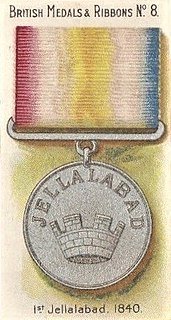
The Jellalabad Medal was a campaign medal issued by the British East India Company. It was established by Lord Ellenborough, the Governor-General of India, on 30 April 1842.
The medal was awarded for the defence of Jalalabad from 12 November 1841 to 7 April 1842, during the First Afghan War, to the troops under the command of Sir Robert Sale. About 2,600 soldiers took part, including the 13th Foot, the 35th Bengal Native Infantry, as well as detachments from other Indian Army units and some loyal Afghan forces.

The Kelat-I-Ghilzie Medal is a campaign medal issued by the British East India Company, to the defenders of the fort at Kelat-I-Ghilzie during the First Anglo-Afghan War.
The following is the list of orders, decorations and medals of British India:



















